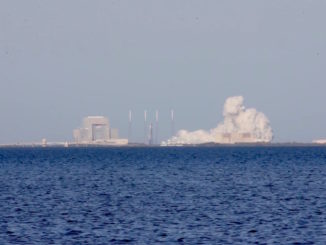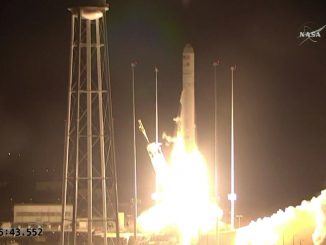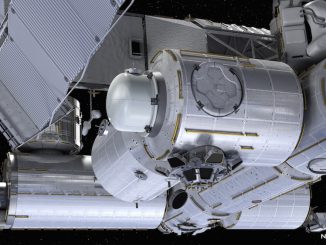
Wrapping up 109 days attached to the International Space Station, a Northrop Grumman Cygnus supply ship departed the orbiting research lab Tuesday to begin an extended four-month mission for additional technology demonstrations and smallsat deployments.
NASA flight engineer Nick Hague, at the controls of the station’s robotic arm, commanded the release of the automated cargo craft at 12:15 p.m. EDT (1615 GMT) as the vehicles soared 260 miles (418 kilometers) over the Pacific Ocean.
The Cygnus spacecraft arrived April 19 at the space station, delivering several tons of supplies, food and experiments. After Tuesday’s departure from the ISS, the cargo craft will deploy several smallsats before plunging into the atmosphere in December, when it will burn up on re-entry with trash loaded by the station astronauts.
Northrop Grumman christened the Cygnus the S.S. Roger Chaffee, after the late astronaut who perished in the Apollo 1 fire in 1967 alongside Gus Grissom and Ed White.
The resupply mission lifted off April 17 on top of an Antares booster from Wallops Island, Virginia. The mission, designated NG-11, marked the 11th launch of a Cygnus resupply ship under Northrop Grumman’s cargo transportation contract with NASA.
The S.S. Roger Chaffee delivered 6,971 pounds (3,162 kilograms) of equipment to the station in April, including food, provisions and 40 mice flying as research specimens to investigate how the animals’ immune systems change in space. The Cygnus spacecraft also carried two Astrobee robots to fly through the station’s modules, and a research facility to test technologies for the production of optical fibers in orbit.
The space station astronauts unpacked the cargo from the Cygnus spacecraft’s pressurized module, made in Italy by Thales Alenia Space. The crew loaded approximately 5,300 pounds, or around 2.4 metric tons, of disposable cargo and trash into the Cygnus spacecraft to burn up during re-entry into the atmosphere, according to Northrop Grumman.
Northrop Grumman’s ground team in Dulles, Virginia, planned to send the Cygnus spacecraft into an orbit some 40 miles (65 kilometers) above the space station’s altitude for deployment of several CubeSats from a NanoRacks module and a Slingshot mechanism.
One of the CubeSats to be released after Cygnus’ departure from the space station is named Seeker, which is scheduled for deployment in about one month. Developed at NASA’s Johnson Space Center in Houston, with a camera system provided by engineers at the University of Texas at Austin, Seeker will perform an inspection of the Cygnus spacecraft to demonstrate in-space navigation and imaging capabilities that could be used on future missions in deep space.
Two AeroCube 10 nanosatellites from the Aerospace Corp. will also separate from Cygnus to conduct experiments in satellite-to-satellite pointing, evaluate the use of a water-based stream thruster, and release 29 tiny atmospheric probes to measure air density in low Earth orbit.
The AeroCube and Seeker missions will deploy from a NanoRacks mechanism outside the Cygnus spacecraft. Several more CubeSats will separate from a Hypergiant SEOPS “Slingshot” deployment system mounted on the Cygnus spacecraft’s hatch bulkhead.
The CubeSat nanosatellites set for deployment from the Slingshot on Cygnus arrived at the space station last month inside a SpaceX Dragon supply ship. The station astronauts transferred the CubeSats from the Dragon cargo craft and installed them into the Slingshot deployment system on Cygnus.
Spaceflight, a rideshare smallsat launch broker based in Seattle, purchased capacity on the Slingshot mechanism from Hypergiant SEOPS for multiple CubeSats, including a nanosatellite named RFTSat from Northwest Nazarene University in Idaho, and the NARSSCube 2 tech demo mission from Egypt’s National Authority for Remote Sensing and Space Sciences.
Spaceflight said an undisclosed CubeSat will also deploy from the Slingshot system on the Cygnus cargo craft.
Northrop Grumman plans several months of long-duration spaceflight experiments using the Cygnus spacecraft after release of the CubeSats. Four miniaturized control moment gyroscopes are flying on the cargo freighter for the first time, and engineers will assess their performance in controlling the spacecraft’s pointing without consuming rocket fuel.
Ground teams also want to evaluate how the Cygnus spacecraft’s avionics function on a long-duration mission, and Northrop Grumman plans to demonstrate dual Cygnus operations for the first time after the launch of the company’s next resupply mission — NG-12 — in October.
Like all previous Cygnus missions, the spacecraft will burn up during re-entry over the Pacific Ocean once the extended mission demonstration is complete. The re-entry is scheduled for Dec. 11.
NASA announced last month its intention to select Northrop Grumman to build a pressurized habitat for the space agency’s planned Gateway mini-space station near the moon. The Gateway will serve as a staging point and safe haven for future human landings on the moon, and Northrop Grumman plans to base its habitat module on the Cygnus spacecraft design.
Email the author.
Follow Stephen Clark on Twitter: @StephenClark1.



